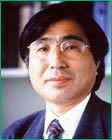Jazz as a research management model?
Dr. Yoshio Hirabayashi came to RIKEN 13 years ago. When Dr. Yoshitaka Nagai, a Group Director at the now-defunct Frontier Research Program, invited Dr. Hirabayashi, who was lecturing at the University of Shizuoka, to join his organization, he immediately replied, “Yes, I’ll go.”
Working within a limited-term research system like FRP was uncommon at that time, and many were surprised that Dr. Hirabayashi had resigned his permanent position to pursue new opportunities. Many “chided me for being odd, but my heart was set having my own laboratory after turning 40. It was around that time that Dr. Nagai made me an offer”, recounts Dr. Hirabayashi.
The opportunities that came with managing an independent research laboratory also brought anxious moments. Dr. Hirabayashi returned to an earlier passion for hints and inspiration- Jazz.
“Jazz is a form of music strongly based on improvisation between the musicians with different instruments and motivations of a quartet or trio to create one piece. A research lab operates in a the similar way. Just as three pianists in a group is unnecessary and most likely unproductive, a research lab needs a variety of people specialize in different areas to make it hum. And just as the members of any jazz rarely stay together for 10 to 20 years, the limited research terms at FRP and BSI keeps improvisations fresh. Research lab leaders are like conductors, coordinating all the sounds, keeping the beat and guiding the music to new harmonies and insights. So you can see how running a research lab is similar having a Jazz group, just the instruments are different.”
Tension notes promote progressive research
Dr. Hirabayashi played piano in a band while in school. Even today, at his family home in Shizuoka, he enjoys tickling the ivories. “Although playing chords on the piano can be difficult, and merely playing chords in a logical progression isn’t much fun to do or listen to, but it is possible to create new sounds. When listening to Jazz or Bossa Nova I often hear weird harmonies and I wonder how they came up with that? A simple chord, Do-Mi-So or C-E-G, is stable, but not very interesting. Adding a different, odd, note might produced an abrasive discord that creates tension but it might just as easily create an intriguing sound. “
The same holds true in the research lab. The mix of skills strikes a “precarious balance (a tension note)” that sustains a continual state of flux that enables the lab to move forward. And, things don’t always go as planned, in music or in research.
“The Chinese characters for the Japanese word for music, ongaku, combines the symbols for sound & enjoyment. This couldn’t be further from the truth. A lot of time is spent ‘struggling with sound’ instead of enjoying it-as the sound refuses to come out right. But in that one moment, that brief instant, when all the diverse tones come together, that is a great feeling. This is true in research, too, in that moment when all the effort comes together in good good data...and we’re ecstatic. For a moment,” he explains, laughing.
Science in the future
Dr. Hirabayashi believes that we are entering a new age of science that will produce a new science.
“While analog methods produced most of the achievements of traditional science, the education of the next generation of scientists have been influenced by by digital technology. So, I wonder what kind of science these minds will create. Most likely they will do it based on a totally different mind-set. Novel ideas and theories typically have been made and refined from analog perspectives, so the new digital generation offers anticipation and anxiety as to what kind of plans and sensibilities they will nurture. Life scientists, for instances, are starting to incorporate computer simulations of complex ecosystems, the essence of digital thinking, into their work. In the future, these models might be able to predict future events. It’s an amazing age coming our way!”
BSI is an extremely unique, comprehensive research environment that has gathered people from diverse fields of interest together. It is here where Dr. Hirabayashi feels this new science will be nurtured. To make this possible, he feels that focus of scientific research should be as broad as possible.
“Neuroscience in particular has an increasing need to incorporate computer theory, medical science, and other types of basic research into its solid biological foundations to flourish. Without a diverse assortment of human resources, even within an established neuroscientific research center, the future generation of researchers will not grow. They will eventually wither away. Since we cannot predict where new research will emerge from, it is important to keep abreast of the diverse directions being taken in research and make unique research a priority.”
Gathering diverse human resources requires that we produce and promote our results far and wide. To spearhead the next generation of brain science, “we must inform society of the directions our research are taking, the results we are expecting to achieve. and the value of these findings in 100 years. That is our social obligation.”






